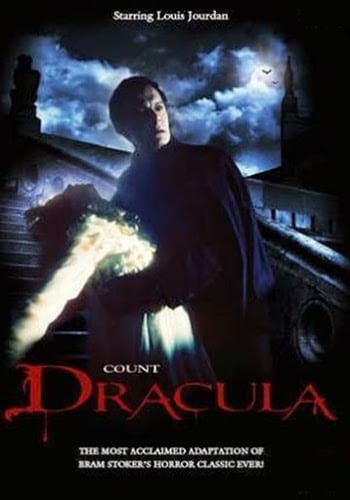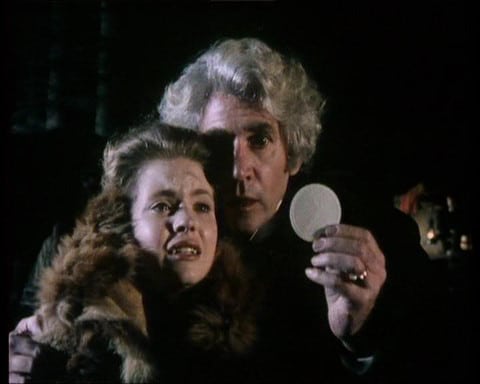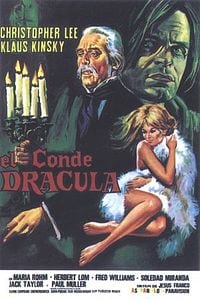Count Dracula (1977)
Directed by: Philip Saville
Written by: Bram Stoker, Gerald Savory
Starring: Frank Finlay, Judi Bowker, Louis Jourdan, Susan Penhaligon
UK [TV movie]
AVAILABLE ON DVD
RUNNING TIME: 152 min
REVIEWED BY: Dr Lenera, Official HCF Critic
Solicitor Jonathan Harker goes to Castle Dracula in Transylvania to meet Dracula, who wants to buy a house in London. After saving Harker from his three Brides, the Count insists that Harker stay in his castle for a month to teach him English. Harker escapes from his room and tries to kill Dracula with a shovel but is made to faint and awakes to find that Dracula has left for Whitby in England, where a ship full of dead bodies washes up on the beach. Staying in Whitby are Harker’s fiancée Mina Westenra and her sister Lucy….
Francis Ford Coppola made a big deal of his 1992 film Bram Stoker’s Dracula being the first screen adaptation of Bram Stoker’s novel to stick to the book. Seeing as his film was extremely close aside from the added love story, he wasn’t entirely lying, and versions in 1970 and 1974 [which I reviewed a couple of days ago] may have claimed the same thing but were largely telling porkies – but he was certainly stretching the truth a bit. There were many at the time who held up this 1977 TV mini-series as a much closer version and, having read the book three times myself over the years, I can safely say now that they were right. There are still a few changes, and it’s odd that they missed the important detail of Dracula getting younger which was in the 1992 version and also the 1970, though the latter was doomed from the start because it was directed by Jess Franco, who lured Chistopher Lee to star because he promised him the film would be faithful to Stoker. For the most part though, this is the book on screen, but it also raises the question of whether being accurate to a written source, even something as famous as Dracula, is always the best option, as it’s by far the slowest moving adaptation I’ve ever seen, and at times its ambition is far too high for its budget. Some parts are extremely atmospheric, but others aren’t too convincing or are weakly realised, and some of more the more stylised moments don’t really come off even though they’re quite unusual, especially for a TV mini-series. As for Louis Jourdan, I can’t really make up my mind about his very low key performance which may have influenced Frank Langella’s in the role.
Bruce Wightman, founder of the Dracula Society and one of the world’s leading experts on Bram Stoker, was involved in an advisory capacity in this production and even had a very small role in it. Made by the BBC, it was shot in the manner of most mini-series’s of the time, with the indoor footage filmed on video and the location stuff shot on film, which means that Count Dracula has a constantly shifting look to it which is hard to get used to. Alnwick Castle in Alnwick, Northumberland doubled for the exteriors of Castle Dracula, while Vale Lodge, Vale of Heath, Hampstead, London was used in a few scenes. One thing that made me very happy as soon as I recognised it was that this version of Dracula was actually partly shot in Whitby, and as far as I know is still the only one, which is totally bizarre. The production was considered so prestigious by the BBC that it forced the cancellation of a Tom Baker Doctor Who serial about vampires because BBC executives feared the viewing public would regard the Doctor Who as a send-up. Count Dracula was first shown on BBC2 as one long movie, then was shown twice in 1979 on BBC1 as three episodes, then in 1993 was shown on BBC2 again, but now in two parts! The DVD seems to contain an obvious break half way through. The 1979 repeats cut the scene where the Brides feed on a baby but the footage was later restored. Response and viewing figures were usually high, but it never came out on video and was considered quite obscure for some time.
For some reason this version is subtitled ‘ A Gothic Romance’ on screen, and this was something that worried me for a while until I realised that I wasn’t going to see another lovesick Dracula. The first third, mostly set in the castle, has quite a chilly feel to it and the small budget actually helps in some moments, such as the lack of a good exterior look at Castle Dracula which means that Harker and the viewer are suddenly there without much of a build-up. The large areas of the castle interiors in darkness help set the right mood, and I was happy to see them quite sparse, bleak and dark for a change, really giving the impression of a very old castle only lived in by one person. The events of the book really are followed almost to the letter here, and the scene with the Brides is far better pulled off than in the 1974 TV movie, the way they’re suddenlyseen sitting at Dracula’s table being quite eerie and the baby eating moment effectively shown by a shot of the baby being held up and then close-ups of the bloody faces of the Brides, though this Dracula is content to just politely scold his women. Again as in 1974, the Demeter voyage is omitted, probably for budgetary reasons, though we do hear about it in some detail. And then we get the Whitby stuff, with Lucy’s graveyard encounter with Dracula [which is basically a rape] first shown for the first time and very well done it is too.
This is all well and good, but the book almost grinds to a halt when it switches to London and Mina is gradually vampirised by Dracula, and on screen this part could really do with tightening and perhaps the extra time allocated to Harker in Transylvania. And writer Gerald Savory still feels the need to change a few things, notably making Lucy and Mina sisters and melding Quincy P. Morris and Arthur Holmwood into a single character named Quincy P. Holmwood. Renfield seems a bit less insane than normal but there’s a nice emphasis on his redemption as he tries to help the good guys and pays for it with his life. In fact this is possibly the most religion-orientated version, with Van Helsing very clearly being a man of faith and given lines that describe very Christian aspects of death and the soul. The pace picks up in a bit once Lucy is a vampire, though the confrontations with Dracula are rather muted. On the other hand, the scene where the Brides attack Mina and Van Helsing in Transylvania is done better than in the 1992 film, being surprisingly scary as the Brides encircle Van Helsing who is desperately trying to shield Mina from the horror. And we get the riding and shooting action at the end, though I wanted to see Harker and Holmwood do their bit in killing off Dracula but is left to Van Helsing.
Though the overall look of the thing isn’t too impressive, director Philip Saville tries very hard to make many moments visually interesting. A tiny Lucy dancing in the foreground as Dracula, with his back to us, bites the real Lucy works really well, and there’s a terrific shot which descends on Renfield’s cell, but the close-up shots of Dracula’s face where they’ve exposed the narrative mostly just annoy. Special effects are mixed – we actually get some shots of real bats along with some fakes ones and Dracula’s transformation from mist to vampire is ecomonically done with Dracula’s face suddenly appearing in close-up amidst the mist and then moving away from the camera to reveal his figure – but an animated mist-type ‘apparition’ [well, I don’t know what it’s supposed to be] coming in through a window is just peculiar. Surprisingly, this one is quite heavy on the sexual aspects, with the moment where Mina sucks blood from Draculas’s chest coming off as more obviously symbolic of fellatio than in any other version. And one new addition I really liked was Dracula visiting Mina while Harker is asleep next to her, this Dracula really having some balls.
And yet Jourdan is quite muted throughout. His best moments are little ones, like him tilting his head slightly while doing the wall climbing bit, as if sensing that Harker’s watching him, or being content just to smile when Harker finds him and his Brides in their coffins in Castle Dracula. But his performance is never allowed to really catch fire and ends up being too subtle for its own good. Much better is Frank Finley’s kindly, intelligent Van Helsing, almost exactly who I imagine the character to be like when I read the book. Susan Penhaligon acts out a great bit when she almost transforms into a vampire in front of several others, and even Harker, often a weak link, is well played by Bosco Hogan. The music score by Kenyon Emrys-Roberts is rather irritating in its almost continual use of the ondes martinet [an early electronic instrument much like the better known theramin], though is brave enough to hold back in places where many other composer’s would have gone for it. I generally enjoyed this Count Dracula for its fidelity, but I can’t help thinking that it’s been somewhat overrated precisely because of its faithfulness, with its flaws being ignored, and I can’t see myself returning to it as often as – say – the 1974 TV one which really surprised me with its many qualities.








Be the first to comment